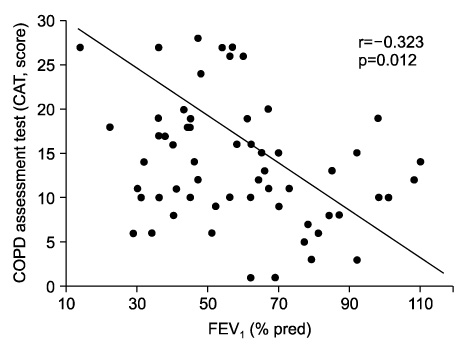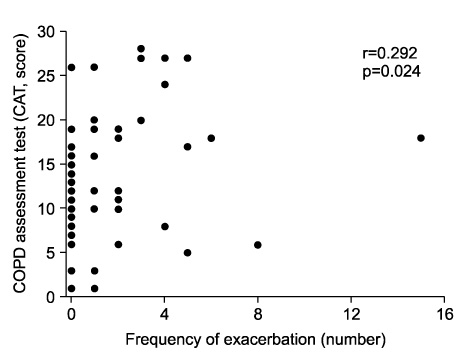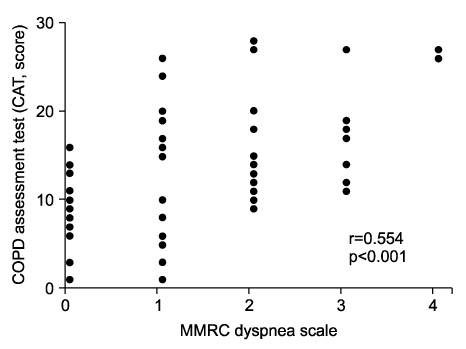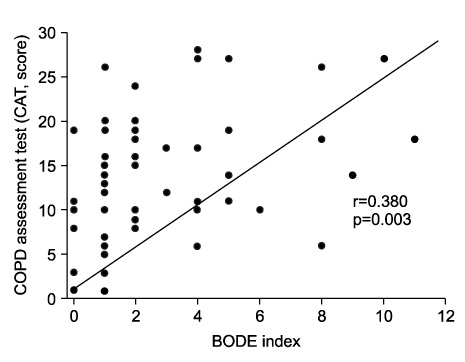Tuberc Respir Dis.
2011 Oct;71(4):271-277.
The Usefulness of the Chronic Obstructive Pulmonary Disease Assessment Test
- Affiliations
-
- 1Division of Respiratory and Critical Care Medicine, Department of Internal Medicine, Gyeongsang National University College of Medicine, Jinju, Korea. ljd8611@empal.com
Abstract
- BACKGROUND
A chronic obstructive pulmonary disease (COPD) assessment test (CAT) has recently been developed as a short and simple method for assessing the quality of life in COPD patients. The object of this study was to assess the usefulness of the Korean version of the CAT for assessing COPD patients in an outpatient clinic.
METHODS
The study included 60 COPD patients in a stable state from an outpatient clinic. The authors investigated the frequency of acute exacerbation during aprevious year through reviewing medical records. We evaluated the spirometry test, a 6-min walk distance test, and obtained the MMRC dyspnea scale, the Korean version of the CAT, and the BODE index at the time of visit. To assess the usefulness of the CAT, correlations between the CAT and other methods were evaluated.
RESULTS
The mean age of patients was 68.3+/-8.6 years and 95% of patients were male. There was a significant correlation between the CAT score and FEV1% (r=-0.323, p=0.012), the frequency of acute exacerbation (r=0.292, p=0.024), the MMRC dyspnea scale (r=0.554, p<0.001), the BODE index (r=0.380, p=0.003), and 6 MWD (r=-0.372, p=0.004). The mean CAT score increased according to the GOLD stage (stage 1, 10.7+/-4.5; stage 2, 13.1+/-7.9; stage 3, 16.3+/-6.2; stage 4, 16.5+/-14.8; p=0.746).
CONCLUSION
The CAT was shown to be useful for the assessment of COPD severity. Therefore, the CAT is an easily applied and simple method for assessing COPD severity in an outpatient clinic.
Keyword
MeSH Terms
Figure
Reference
-
1. Global strategy for diagnosis, management, and prevention of COPD. Global Initiative for Chronic Obstructive Lung Disease (GOLD). c2010. cited 2011 Sep 30. [place unknown]: GOLD;Available from: http://www.goldcopd.org/Guidelines/guidelines-global-strategyfor-diagnosis-management.html.2. Mannino DM, Reichert MM, Davis KJ. Lung function decline and outcomes in an adult population. Am J Respir Crit Care Med. 2006. 173:985–990.3. Wolkove N, Dajczman E, Colacone A, Kreisman H. The relationship between pulmonary function and dyspnea in obstructive lung disease. Chest. 1989. 96:1247–1251.4. Celli BR, Cote CG, Marin JM, Casanova C, Montes de Oca M, Mendez RA, et al. The body-mass index, airflow obstruction, dyspnea, and exercise capacity index in chronic obstructive pulmonary disease. N Engl J Med. 2004. 350:1005–1012.5. Havlucu Y, Çelik P, Dinç G, Şakar A, Yorgancioğlu A. Assessment of quality of life in chronic obstructive pulmonary disease. Turkish Respir J. 2005. 6:78–83.6. Jones PW, Harding G, Berry P, Wiklund I, Chen WH, Kline Leidy N. Development and first validation of the COPD Assessment Test. Eur Respir J. 2009. 34:648–654.7. Lee S, Lee JS, Song JW, Choi CM, Shim TS, Kim TB, et al. Validation of the Korean version of chronic obstructive pulmonary disease assessment test (CAT) and Dyspnea-12 questionnaire. Tuberc Respir Dis. 2010. 69:171–176.8. ATS Committee on Proficiency Standards for Clinical Pulmonary Function Laboratories. ATS statement: guidelines for the six-minute walk test. Am J Respir Crit Care Med. 2002. 166:111–117.9. Farkas J, Kosnik M, Zaletel-Kragelj L, Flezar M, Suskovic S, Lainscak M. Distribution of self-rated health and association with clinical parameters in patients with chronic obstructive pulmonary disease. Wien Klin Wochenschr. 2009. 121:297–302.10. Sanchez FF, Faganello MM, Tanni SE, Lucheta PA, Padovani CR, Godoy I. Relationship between disease severity and quality of life in patients with chronic obstructive pulmonary disease. Braz J Med Biol Res. 2008. 41:860–865.11. Weatherall M, Marsh S, Shirtcliffe P, Williams M, Travers J, Beasley R. Quality of life measured by the St George's Respiratory Questionnaire and spirometry. Eur Respir J. 2009. 33:1025–1030.12. Burrows B. Predictors of loss of lung function and mortality in obstructive lung diseases. Eur Respir Rev. 1991. 1:340–345.13. Kanner RE, Anthonisen NR, Connett JE. Lung Health Study Research Group. Lower respiratory illnesses promote FEV1 decline in current smokers but not ex-smokers with mild chronic obstructive pulmonary disease: results from the lung health study. Am J Respir Crit Care Med. 2001. 164:358–364.14. Donaldson GC, Seemungal TA, Bhowmik A, Wedzicha JA. Relationship between exacerbation frequency and lung function decline in chronic obstructive pulmonary disease. Thorax. 2002. 57:847–852.15. Rasekaba T, Lee AL, Naughton MT, Williams TJ, Holland AE. The six-minute walk test: a useful metric for the cardiopulmonary patient. Intern Med J. 2009. 39:495–501.16. Casanova C, Cote CG, Marin JM, de Torres JP, Aguirre-Jaime A, Mendez R, et al. The 6-min walking distance: long-term follow up in patients with COPD. Eur Respir J. 2007. 29:535–540.17. Nishimura K, Izumi T, Tsukino M, Oga T. Dyspnea is a better predictor of 5-year survival than airway obstruction in patients with COPD. Chest. 2002. 121:1434–1440.18. Hajiro T, Nishimura K, Tsukino M, Ikeda A, Oga T, Izumi T. A comparison of the level of dyspnea vs disease severity in indicating the health-related quality of life of patients with COPD. Chest. 1999. 116:1632–1637.19. Regueiro EM, Di Lorenzo VA, Basso RP, Pessoa BV, Jamami M, Costa D. Relationship of BODE Index to functional tests in chronic obstructive pulmonary disease. Clinics (Sao Paulo). 2009. 64:983–988.20. Cardoso F, Tufanin AT, Colucci M, Nascimento O, Jardim JR. Replacement of the 6-min walk test with maximal oxygen consumption in the BODE index applied to patients with COPD: an equivalency study. Chest. 2007. 132:477–482.21. Ko FW, Tam W, Tung AH, Ngai J, Ng SS, Lai K, et al. A longitudinal study of serial BODE indices in predicting mortality and readmissions for COPD. Respir Med. 2011. 105:266–273.22. Martinez FJ, Han MK, Andrei AC, Wise R, Murray S, Curtis JL, et al. Longitudinal change in the BODE index predicts mortality in severe emphysema. Am J Respir Crit Care Med. 2008. 178:491–499.23. Haruna A, Muro S, Nakano Y, Ohara T, Hoshino Y, Ogawa E, et al. CT scan findings of emphysema predict mortality in COPD. Chest. 2010. 138:635–640.24. Han MK, Bartholmai B, Liu LX, Murray S, Curtis JL, Sciurba FC, et al. Clinical significance of radiologic characterizations in COPD. COPD. 2009. 6:459–467.25. Pauls S, Gulkin D, Feuerlein S, Muche R, Krüger S, Schmidt SA, et al. Assessment of COPD severity by computed tomography: correlation with lung functional testing. Clin Imaging. 2010. 34:172–178.
- Full Text Links
- Actions
-
Cited
- CITED
-
- Close
- Share
- Similar articles
-
- Nutritional Assessment in Patients with Chronic Obstructive Pulmonary Disease
- Cor Pulmonale with Particular Reference to Chronic Obstructive Pulmonary Disease and Pulmonary Tuberculosis
- Usefulness of COPD Assessment Test as valuable predictor of depression in chronic obstructive pulmonary disease
- Management of Chronic Obstructive Pulmonary Disease
- Pathophysiology of Chronic Obstructive Pulmonary Disease






